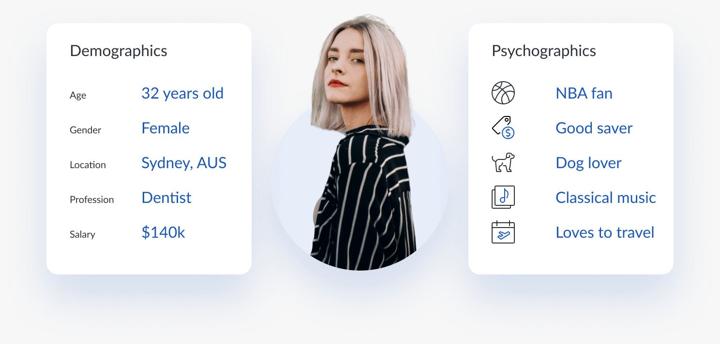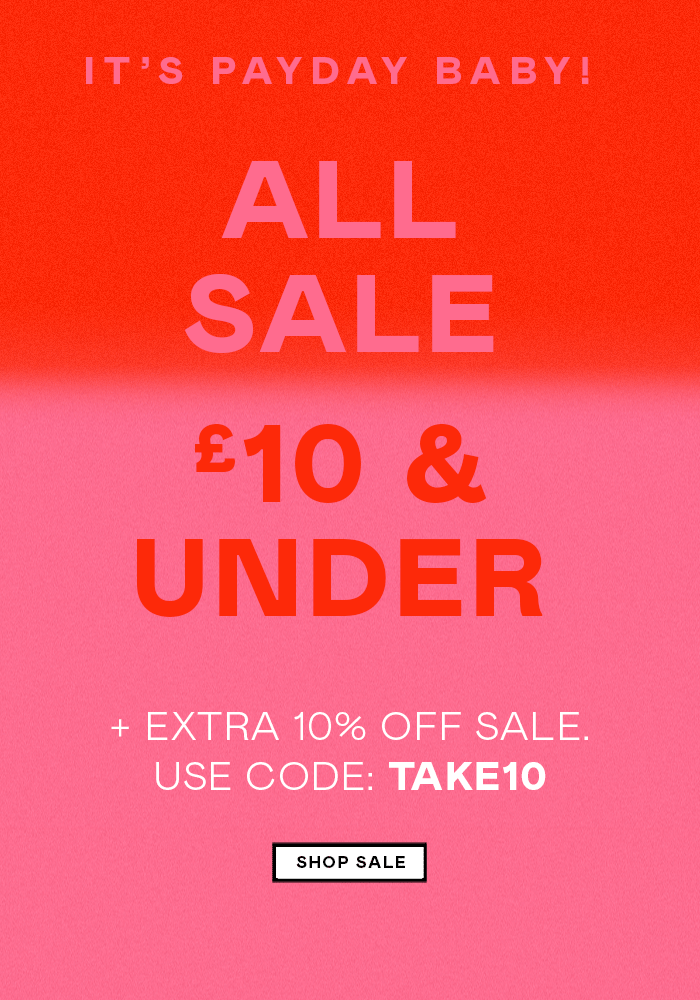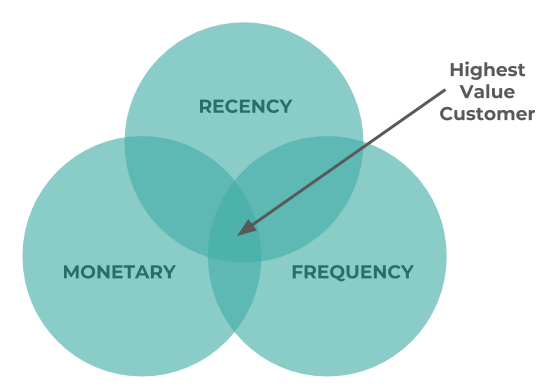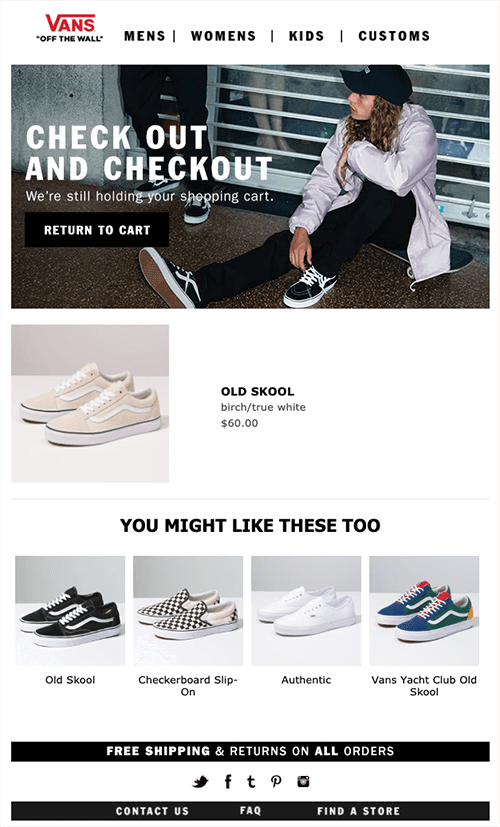Gmail’s Promotions tab is indeed a godsend for us users—it's the perfect place for all sales, offers, and discount-related emails that we can go through at our convenience, if and when that happens.
Unfortunately, that’s what your email can end up being—just another email in the Promotions tab (or worse, the spam folder) that doesn’t excite subscribers—if you follow the “spray and pray” strategy and blast the same email campaigns to everyone. Sent to all, targeting a few and appealing to none.
Today, 80% of consumers are most likely to purchase when brands offer a personalized experience, while 66% say encountering non-personalized content repels them from buying. Those numbers are massive, making personalizing your eCommerce marketing messages a no-brainer.
Per Bloomreach, eCommerce personalization is the practice of using data to know, guide, and impress your customers—with experiences that are so relevant and contextual, they feel like magic.
And the key to creating this magic for your customers is segmentation.
Customer segmentation is dividing your customers into groups with similar interests and behavior, so you can send targeted and relevant marketing messages and boost engagement and conversions.
This article will take a deep dive into how you can leverage segmentation for eCommerce personalization. These two powerful tools, when combined, can help you understand your audience better, improve their experience at your store, and ultimately optimize your marketing spend and returns.
Let’s begin!
Why is customer segmentation important for your business?
Truth bomb: Your customers are not a homogenous group—they comprise people across age, gender, interests, lifestyles, shopping habits, and income groups—to name a few.
Segmentation works by dividing your customers into smaller groups based on shared characteristics. It’s the difference between promoting the same offers to everyone versus personalizing the way you speak to specific groups of customers based on their particular needs and journey.
Customer segmentation helps you:
- Understand your customers better: You get to understand them at the granular level—their behaviors, shopping patterns, habits, and why they act the way they do.
- Create targeted and relevant marketing messages: The above information allows you to create effective marketing campaigns that suit the needs of each segment—instead of broadcasting the same message to everyone in your audience.
For example, segmentation can tell you who within your audience purchased from you only when they got a discount. This way, you’ll know who your coupon lovers are and how to entice them to buy again.
- Identify the best marketing channels for your store: For instance, if you see that Facebook Ads bring you the most traffic and most high-paying customers, you’d know which channel to double down on.
- Improve returns on marketing campaigns: By creating campaigns and ads that meet each segment of customers where they are and resonate with them, you can improve your conversion rates and return on investment (ROI) on marketing.
- Enhance customer retention and loyalty: Providing personalized experiences to shoppers can make them feel you understand them and their needs and interests, improving customer satisfaction and their chances of returning to your store for future needs.
Nutshell: Besides ensuring optimal use of your marketing budget, segmentation allows you to build more meaningful relationships with your current customers and reach more potential customers based on the insights revealed.
The million-dollar question is, what’s the best way to segment your customers, and how can you achieve all these benefits?
Let’s find out!
8 best practices to ace customer segmentation for eCommerce
Traditionally, customer segmentation has focused chiefly on grouping customers based on demography (age, gender, occupation) and geography.
But marketers today have a goldmine of information—down to the device their customers use and how they behave on their website—that they can tap into.
Here’s how to best use this data with your online store platform to create customer segments and inform your marketing strategies:
Leverage psychographic segmentation
A recent report revealed that nearly 70% of customers buy from companies whose values align with theirs, whose products match their social beliefs.
This makes it crucial to market to customers not just based on their gender or where they live but also based on the values they stand for. And this is where psychographic segmentation helps.
Psychographic segmentation is digging deeper into your shopper’s personality, lifestyle, values, interests, hobbies, beliefs, and social status and creating segments based on that.
While demographic segmentation tells you who purchases your product, psychographic data shows you why they buy by looking at characteristics like personality, values, attitude, and lifestyle.

It seeks to look at what motivates your customers and what principles they have, so you can market your brand and products in a way that ties back to them.

This email campaign from NastyGal appealed to the lifestyle of the young working women waiting for payday to shop and even spoke their language.
Once you learn this information about your audience, understanding what to promote (and not) to whom and how becomes relatively easy. For instance, if you know a shopper is purely vegan, you wouldn’t want to advertise your latest fur coat or leather shoes to them.
But the real question is, how do you gather this data about your audience?
To start with, look at your customer’s search or purchase history for clues. For example, a customer who only purchases from your eCommerce store's “sustainable” section is likely a part of the environmentally-conscious market.
So, in your next marketing email to them, you could highlight some more of your eco-friendly products—to show you know and understand them and bring them back to your store.
Customers’ previous purchases, their total order value, or sometimes, even the device they use can also tell you about their lifestyle and purchasing power.
Besides these, market research, customer surveys and interviews, and social media can yield rich insights into your target audience’s interests and likes.
Bottom line: Go beyond demographics—even customers with the same demographic data can have different interests and shopping behaviors, which is where psychographic segmentation helps.
Segregate new visitors based on traffic source
Simply segmenting your visitors based on whether they’re new or returning doesn’t cut it anymore—you should also create micro-segments among your new visitors based on where they came from.
Did they come from social media, search engines like Google, email, an influencer link, or a referral from another website?
Clubbing customers into segments based on traffic sources can help you understand where to reach each group, how to communicate to them, and how shopping behavior differs across sources.
For instance, you might notice that visitors coming to your store from search are more likely to buy, while those who come across your products while surfing Facebook often just casually browse your store and leave.
Or, that visitors from Instagram usually spend a good time on your store and add products to their cart, so running ads on this platform could be profitable.
In general, this information can help you understand which channels work best for you, which ones bring in regular or high-paying customers, and thus, optimize your marketing efforts. You can even consider creating custom landing pages for different sources to smoothen customers’ experiences and conversion paths.
And, it can also give you insights into your visitors—for instance, if they came from a particular influencer you partnered with, you’d know your visitors follow them and are interested in that type of niche and content.
Personalize experiences for return visitors
“A bird in the hand is worth two in the bush.” Translation: While it’s good to get new visitors, your returning visitors, who are already interested in your offerings, are also an important segment that you should nurture.
Unlike new visitors, repeat visitors already know your store, products, and prices. And the fact that they’re returning shows they’re seriously considering buying from you, probably after having explored other alternatives.
In short, they are solid potential buyers. And personalized messages at this stage can help improve their experience, differentiate your store, and seal the deal.
There are many ways you can do this:
- Send your return visitors a welcome message through your chatbot, highlighting that you’re happy to see them or asking if they have any questions.
- Offer them personalized chat support to resolve any queries to take them closer to a purchase.
- Prompt them to check out the products they wish-listed, added to the cart, or last browsed and inform them if there are any new deals on them.
- Show them “you might also like” recommendations based on the above and what they’ve previously bought.
- Show them your latest collection considering their browsing and purchase history.
- Offer them a discount to enhance their experience at your store and incentivize them to purchase.

OptinMonster here uses a warm welcome message for their return visitors and entices them with the idea of a “gift.”
Leverage browsing history
Tracking browsing history is crucial to segmenting your customers effectively—it takes the guesswork out of understanding what your customers are interested in and likely to buy.
But how do you leverage it for marketing?
One way is to track your visitors’ on-site behavior and then club all those who viewed a specific item, category, page, or browsed a particular brand together to create segments.
You can then send each segment personalized email campaigns or retargeting ads. Here, you can highlight the products they browsed and entice them to come back, offer recommendations, product comparisons, or even discounts or coupons to bring them closer to purchasing.
For example, this is how Moosend retargets visitors who visited its “MailChimp alternatives” post. They use price differences to highlight why they’re better and incentivize visitors to purchase.
Or, you can also take action while users are at your store.
Visitors who have spent a certain amount of time browsing your store but not taken any action might need some assistance, guidance, or motivation to buy.
This is where you can launch your chatbot—ask them about their preferences, so you can direct them to the products they’re looking for or suggest relevant products based on what they’ve been browsing.
This can help smoothen their experience at your store and increase their chances of conversions.

Bonus: Tracking browsing history also allows you to measure the Page Visits: Purchases Made ratio of products. So, you can understand which products, categories, or brands sell better and concentrate on promoting them.
Double-down on the high-spending group
Applying Pareto’s 80/20 rule to business, 80% of your sales and revenue come from 20% of your customers. And as an eCommerce store, you need to identify and nurture this 20% segment—your high-spending group.
This group comprises those customers who have spent more than the average customer lifetime value (CLV). They either shop regularly or place large orders every few weeks or months, bringing in significant revenue for you.
Once you segment your customers based on how much they spend and find your high-spending group, the next step is to nurture them and show appreciation for their commitment to your brand.
You can do this by offering them exclusive discounts, first dibs on new launches, express or free shipping, freebies, etc.
The idea is not just to identify this segment but also to retain them since they bring in more revenue than other customer segments.
Understanding your most profitable customers' characteristics, lifestyle, and likes can also help you identify and reach similar members in your target audience.
But note: Your high-spending consumer may not always be your most valuable customer. For instance, someone who ordered in a large quantity once but never returned is not your ideal customer.
Moreover, focusing on and delighting solely those customers who spend the most on your store might put at a disadvantage those who purchase from you consistently but with a lower transaction amount.
This is where the Recency, Frequency, and Monetary (RFM) model comes into the picture, helping you understand shopper behavior and your most valuable segments:
- Recency: How long ago did the customer last purchase?
- Frequency: How many orders/purchases do they make over a fixed period?
- Monetary value: How much do they spend on your store over a fixed period?
Your highest-value customers are those who frequently purchase, keep coming back to your store, and spend above a specific amount—so double down on and nurture them.

Laser focus on cart abandonment
A massive 70% of customers abandon their shopping carts—and concentrating on and personalizing your message to your store’s cart abandoners can help you recover lost sales and revenue.
The first step is to track on-site behavior and identify your cart abandoners—customers who added products to their cart but didn’t complete the purchase. Then, use cart recovery emails and retargeting ads reminding customers of what they left behind or offering discounts to entice them to return to your store.
But remember, not every abandoned cart merits a recovery email, and you should also personalize your emails for different cart abandoners.
So, what you can do to understand whom to target and how is to segment your cart abandoners further based on:
- Repeat vs. first-time shoppers: Repeat purchasers are already familiar with your brand and products, but first-time shoppers might need more convincing to get them to part with their money.
Think about what can help you get the latter interested in your brand, build trust, and convert them—discounts, coupon codes, customer reviews, user-generated content (UGC)—and plan your abandoned cart email’s content accordingly.
On the other hand, you already have data on your repeat shoppers and what products they like. So, including some recommendations in your cart recovery emails to give them more options can be a good idea.

- Cart value: Next, instead of emailing all your cart abandoners, you might want to focus on the more lucrative customers with a higher cart value.
So, for instance, you can send emails only to shoppers whose cart value exceeded a specific threshold (like $300) or was more than your average order value (AOV).
Or, you can give customers with higher cart total better discounts or free shipping to motivate them to purchase.
There are many more ways you can segment your cart abandoners further—from the number of items in their cart to whether they added a high-value product and the days since they left the cart—but these two take the cake.
Create groups based on satisfaction levels
An underrated tactic that can help boost your business’ growth is segmenting customers based on their satisfaction levels.
After a customer has purchased from your store or interacted with your customer service, send them a simple Net Promoter Score (NPS) or Customer Satisfaction (CSAT) survey to see how you’re doing on this front.
Then, segment your customers into two groups, satisfied (those who gave higher scores) and unsatisfied, and interact with each one differently going forward.
Your happy customers, for instance, are far more likely to buy from you again. So, you can create personalized email campaigns for this segment, ask them to leave reviews, offer them discounts, give them early access to products or freebies to delight them.
The idea is not just to assess how satisfied your customers are but also to nurture and retain this group—providing them excellent experience continuously can turn them into loyal brand advocates.
At the same time, also work towards improving the experience of your unsatisfied segment and giving them the support they need. This can help you contain the negative reviews they might leave about your brand and prevent you from losing their business.
So, for instance, you could offer your unhappy customers discounts to make up for the negative experience. Or, you could make it a point to attend to these customers and resolve their needs personally the next time they visit your online store.
Segment according to shopping personas
Finally, you can segment your customers and create shopping personas based on how they interacted with your store and their purchase history and shopping habits.
Here are some typical shopper personas and how you can market to them to increase sales:
- One-timers: These customers have purchased from your shop only once. You can upsell and cross-sell your products in your marketing emails to entice them to buy again.
- Thrifty shoppers: They purchase from you frequently, but they’re on a budget and only buy what they need at a given moment. You can personalize your communications to this segment by observing when they purchase and incentivizing them with discounts a few days before their next expected purchase.
That email campaign from NastyGal fits well here—they directed it to working professionals who might not be keen on splurging. And, they sent the email on payday since that was when their target group was likely to shop.
- Coupon lovers: They buy from you only when they get a discount, and the best way to tap them and bring them in for a repeat purchase is to offer discounts—as long as they don’t cut into your profits.
- Indecisive shoppers: These people spend a lot of time browsing your website but rarely buy—a little nudge can help reassure and convert them.
You can do this by offering live chat support, more information on the item they’re browsing, your return/exchange policy, and highlighting your product’s benefits and social proof in your emails.
- Trendy shoppers: They come back to your store whenever there’s a new product or collection. Promotional emails telling them about your “new in” items are a great way to get them to buy faster.
- Loyal customers: These are every eCommerce store owner’s favorite—they buy from you regularly, know your products and pricing, and are likely to recommend you to their friends and family.
Reward and nurture these customers, so they keep bringing in business. You can offer them exclusive discounts, start a loyalty or referral program, and make them feel appreciated by actively asking for their feedback on products.

Bottom line: Understanding your shoppers’ behavior and how and why they buy can help you tailor your marketing to their needs, thus, increasing sales.
Conclusion
Spray and pray doesn’t work in eCommerce anymore, especially when many customers expect personalized offers from the brands they interact with.
In this context, customer segmentation can help you tailor your offers for each type of customer, meet them where they are, and make the most of your marketing efforts.
These 8 tactics are some of the most effective ways to get started with and leverage segmentation.
But remember, you don’t have to get started with all of them at once, and there’s no one-size-fits-all strategy. Experiment and see what works for your store, and most importantly, take the time to understand your audience to plan and guide your strategy.
